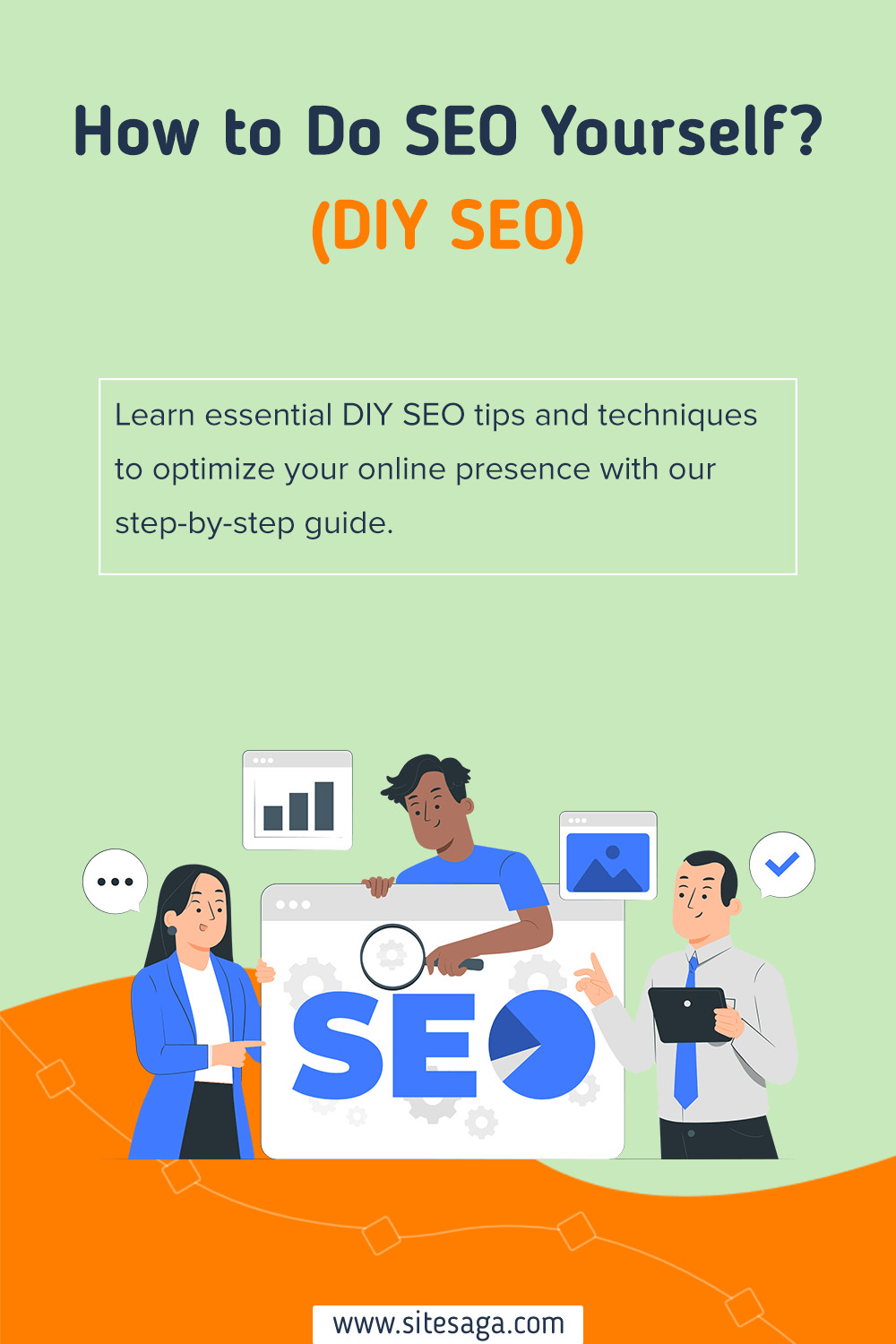Are you looking online for how to do SEO yourself? Do you want to improve your website’s visibility and gain significant traffic? If so, then you’ve come to the right place.
Learning the skill of Search Engine Optimization (SEO) is critical for anyone trying to stand out and succeed on the internet.
Whether you own a business, maintain a blog, or simply want to improve your internet presence. It’s vital to understand the fundamentals of SEO to take control of your digital future.
While many people regard SEO as a complex and professional field, the truth is that everyone can learn to properly optimize their website.
In this comprehensive guide, we’ll walk you through the essential steps of how to do SEO yourself. Here are some practical ideas and concrete tips for increasing the visibility of your website and driving organic traffic.
Let’s dive in.
Can You Do SEO Yourself?
Yes, you can perform SEO (Search Engine Optimization) on your own. To cut costs and keep complete control over SEO, many people and small businesses decide to do their own SEO.
With so many online resources and tools at their fingertips, motivated people may easily learn and apply SEO strategies.
Though it’s possible to perform SEO on your own, it takes commitment and time to constantly learn about new SEO techniques. Keeping updated with the most recent best practices is essential to achieving significant results in the dynamic world of SEO.
Benefits of Doing SEO Yourself
For individuals or small enterprises on a budget, performing SEO yourself can have several advantages. The following are some benefits of managing your own SEO:
- Hiring a professional SEO agency can be expensive. As a result, you can save money by doing it yourself, eliminating the need for those costs.
- Provides complete control over your SEO strategies, ensuring they align with your specific goals and vision.
- Allows you to quickly implement changes and updates without having to go through a third-party agency, leading to faster results.
- You gain a deeper understanding of how search engines work, online marketing techniques, and your overall web presence.
- Helps you adapt and adjust your SEO strategies to stay current with search engine algorithms and market trends.
- Managing SEO yourself allows you to tailor strategies to fit your brand’s unique characteristics and meet your target customers’ preferences.
- As you’re directly responsible for SEO, you can concentrate all your efforts and attention on improving your website’s rankings.
- You can fully experiment with different SEO techniques, keywords, and content strategies to find what works best for your site.
Despite these benefits, it’s crucial to remember that SEO is possibly a complex and constantly-evolving industry. Keeping up with best practices and algorithm upgrades requires major time, effort, and research investment. Nonetheless, consider hiring an SEO specialist if you lack the skills you need.
9 Steps to Do SEO Yourself (DIY SEO)
Setting SEO goals is critical for getting the most out of DIY SEO. Let’s look at how to set a target based on where the business is right now.
1. Keyword Research and Identify Relevantly High-Traffic Keywords
Keyword research and identifying high-traffic keywords for SEO are crucial to attracting targeted organic traffic. It enables you to identify what terms people use to search for content in your niche and develop relevant content.
You boost your chances of ranking higher in search engine results by selecting the proper keywords with significant search volumes.
Here’s a step-by-step guide to keyword research and finding high-traffic keywords for your SEO efforts:
i. Understand Your Niche and Goals
Before you begin keyword research, you must have an in-depth knowledge of your niche, target audience, and business goals. Define the purpose of your website or content, as well as your goals for SEO.
ii. Brainstorm Seed Keywords
Begin by generating a list of seed keywords related to your niche. These are broad keywords that describe your content’s core topics or themes.
For example, if your website is about fitness, then some seed keywords could be “workout routines,” “weight loss,” etc.
iii. Use Keyword Research Tools
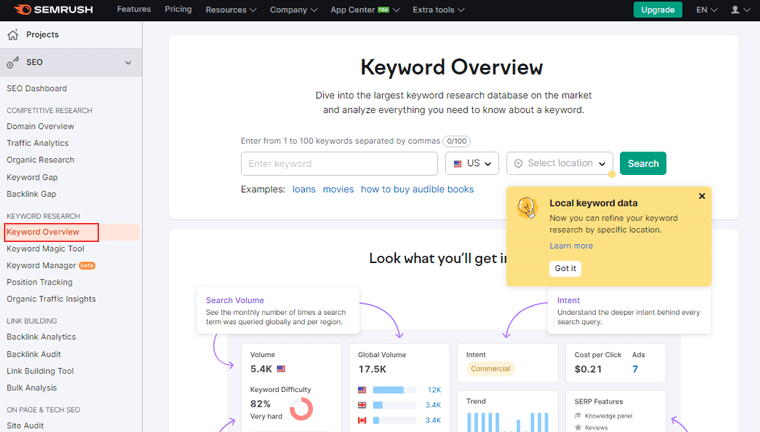
There are several keyword research tools available to help you find relevant keywords and their search volumes. Some popular tools include Google Keyword Planner, Ahrefs, Semrush, Moz Keyword Explorer, and Ubersuggest.
iv. Expand Your Keyword List
Based on your seed keywords, use the keyword research tool to get a list of similar keywords. These tools will give you additional keyword recommendations as well as their monthly search volumes and competition levels.
v. Analyze Search Volumes and Competition
Search for keywords that have a good balance of search volume and competition. High search traffic suggests that many people are looking for that term, but it also indicates that competition is intense. Meanwhile, low-competition keywords are easy to rank but have lower search volumes.
vi. Consider Long-Tail Keywords
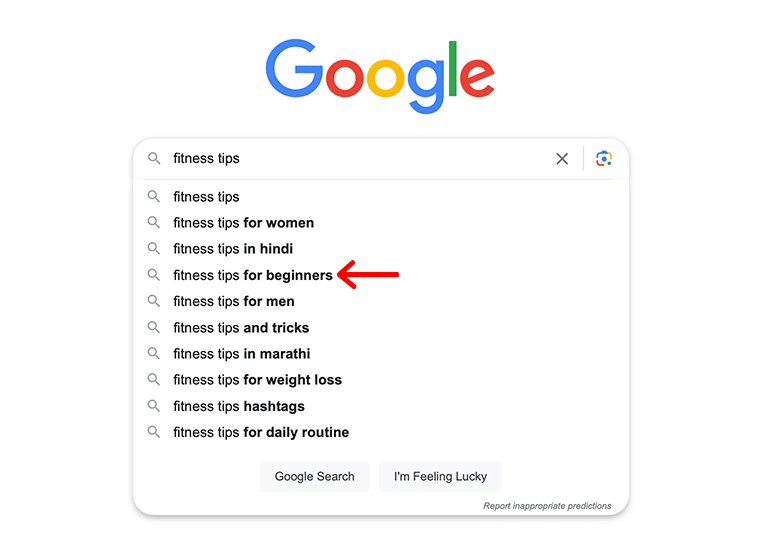
Long-tail keywords are keyword phrases that are longer and more detailed. While they may have lower individual search numbers, they frequently have higher conversion rates and are easier to rank for.
Instead of targeting “fitness tips,” you may target “fitness tips for beginners.”
vii. Analyze Competitor Keywords
Identify your main competitors in the niche and research the terms they are using. This might provide useful information on which keywords are bringing visitors to their websites.
viii. Prioritize Intent
Take into account the search intent behind each keyword. Some keywords may suggest a need for information, while others may imply a desire for a transaction or navigation. To attract the right audience, align your content with the searcher’s intent.
ix. Organize and Group Keywords
Similar keywords should be grouped based on their subjects. This can help you produce content around key topics and improve the general layout of your website.
x. Monitor and Update
Keyword research is a never-ending activity. Monitor the performance of your selected keywords regularly and make changes as appropriate. To remain competitive, keep upgrading your content and targeting new relevant keywords.
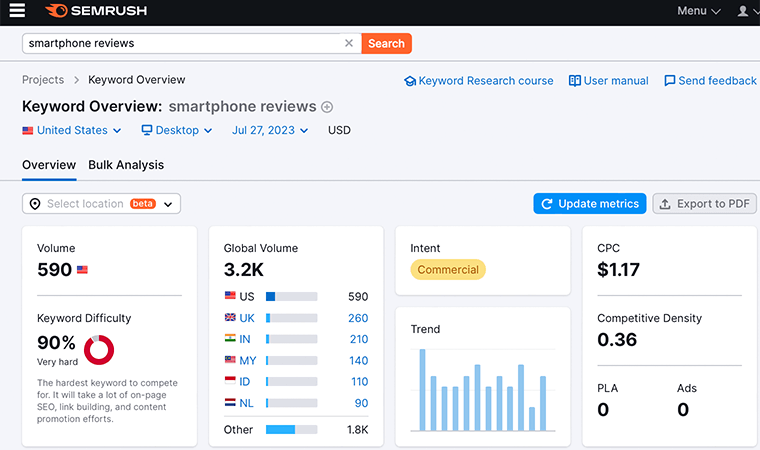
Examples of Keyword Research and High-Traffic Keywords
Let’s assume you’ve got a website about the latest smartphone reviews, and you want to find relevant and high-traffic keywords.
- Seed Keywords: Smartphone reviews, phone review website, mobile rating seed.
- Keyword Research Tool: You use the Semrush tool to find related keywords.
- Expanded Keyword List: Latest iPhone reviews and features, budget smartphones, etc.
- Analyze Search Volumes and Competition: Among the suggested keywords, “smartphone reviews” has a high search volume and moderate competition, making it a potential target.
- Consider Long-Tail Keywords: You also notice long-tail keywords like “best budget smartphone reviews” and “best website for smartphone reviews” with moderate search volumes but lower competition.
- Analyze Competitor Keywords: You analyze a top competitor’s website and find that they are ranking well for “best cheap smartphone reviews” and “samsung smartphone reviews.”
- Organize and Group Keywords: Group the smartphones by categories like “samsung,” “cheap,” “apple,” “latest,” etc., and optimize the content around these specific topics.
- Monitor and Update: Check the performance of your content regularly, track keyword ranks, and adjust your strategy based on changes in search trends.
You can find relevant, high-traffic keywords and boost your website’s SEO by following these steps and constantly improving your strategy.
2. Create a High Quality and Engaging Content
It’s crucial to produce informative and interesting content for SEO. Lower bounce rates, longer browsing sessions, and more user involvement help to draw and keep visitors.
Additionally, high-quality content generates more social shares and backlinks, which improves SEO ranks. Hence, quality content builds authority and develops loyal customers, all of which increase organic search performance.

Creating high-quality and engaging SEO content requires a structured approach. It combines relevant data, user intent, and an optimized structure. Here’s a step-by-step guide to creating SEO-friendly content on your own:
- Understand User Intent – Analyze the intent behind each keyword/search. Tailor your content to the user’s intent. For example, if the term is “best travel destinations”, then people are likely to seek out useful articles that highlight various destinations.
- Catchy Headlines – Your headline is essential for capturing attention and encouraging clicks. It should be descriptive, interesting, and, if possible, include the target keyword. For instance, “10 Unexplored Places for Adventure Travelers” or “The Ultimate Guide to Budget-Friendly Vacations.”
- Create Valuable and Unique Content – Provide insightful and well-researched content. You should back up your claims with trustworthy sources and data. For example, if you’re creating a blog post about the “Top 10 Hiking Trails”, then it should include extensive descriptions, difficulty levels, and stunning images of each trail.
- Use Multimedia – Provide insightful and well-researched content. You should back up your claims with trustworthy sources and data. For example, if you’re creating a blog post about the “Top 10 Hiking Trails”, then it includes extensive descriptions, difficulty levels, and stunning images of each trail.
- Optimize for Readability – To make your information easy to read and scroll, use short paragraphs, bullet points, subheadings, and straightforward language. In fact, online users appreciate easily scannable and well-organized content.
Remember that high-quality and engaging content builds audience trust and promotes your website as an authoritative source in your niche.
3. Perform On-Page SEO
On-page SEO is critical for increasing the visibility of your website in search engine results. Individual web pages must be optimized with relevant keywords, meaningful titles, and appropriate headings. This raises the likelihood that search engines will understand and rank your content higher.
Furthermore, it helps search engines understand the relevancy of your content, making it critical for drawing targeted traffic and attaining online success.
Performing on-page SEO yourself is a cheap way to boost your website’s search engine rankings. Here are some guidelines to get you started with on-page SEO:
Optimize Page Titles
- Using your target keywords, create engaging and descriptive page titles. Keep the title length around 60 characters to ensure a good presentation in search results.
- Example: Instead of “Welcome to Our Website,” use “Elevate Your Home with Chic Décor | XYZ Home Decor.”
Meta Descriptions
- Write short and compelling meta descriptions (about 160 characters) that include relevant keywords and provide an overview of the page’s content.
- Example: “Transform your living spaces with exquisite home decor pieces from XYZ Home Decor. Discover stylish accents and timeless designs to create your dream home today!”
URL Structure

- Create clean and SEO-friendly URLs that contain relevant keywords and are easy for users to understand.
- Example: Instead of “www.example.com/product?id=12345”, use “www.example.com/handmade-decor.”
Heading Tags
- Use heading tags to appropriately organize your content. The H1 element should include the major keyword and represent the main topic of the page.
- Example:
<h1>Handmade Decor for Home</h1>
<h2>Why Choose Handmade Decor?</h2>
<h3>Tips and Tricks for Latest Home Trends </h3>
Keyword Placement in Content
- Include your target keywords naturally throughout the article, but avoid keyword stuffing (unnaturally overusing keywords).
- Example: “Elevate your space with one-of-a-kind creations. Explore our exquisite collection for artisanal charm and personalized style.”
Image Optimization
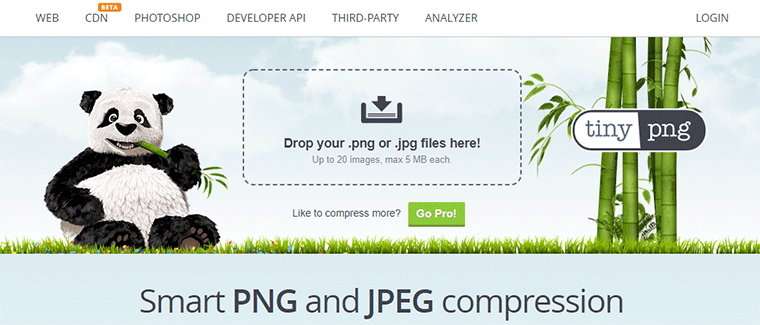
- Images should be compressed to improve loading times and have descriptive alt tags. Also, include relevant keywords to help search engines understand the image content.
- Tools such as TinyPNG, Compressor.io, and Optimizilla help you compress your image files without affecting the quality of the image.
- Example: <img src=”home-decor.png” alt=”Handmade Decor for Home”>
Mobile-Friendly Design
- As Google favors mobile-friendly sites in search results, make sure your website is responsive and appears properly on all devices.
- Example: Use a responsive design that adapts to different screen sizes, making it easier for mobile users to navigate and interact with your content.
Are you confused between on-page SEO and off-page SEO? Then, read this comparison article on on-site SEO vs off-site SEO to clear all your doubts.
4. Build an Internal Link
Building internal links is an important aspect of SEO that enhances both the user experience and the search engine rankings of your website.

Internal links are clickable links between pages within the same domain as your website. They assist search engines in more efficiently crawling and indexing your website and directing readers to appropriate content.
Here is an instruction with examples of how to create internal links yourself:
a. Create High-Quality Content:
- Make sure your website has useful and helpful information before you begin creating internal links. Better content will inevitably result in more links from other pages on your website.
b. Identify Target Keywords and Pages:
- Choose the main keywords or topics you wish to emphasize for each page of your website. For instance, if you’ve got a blog post about “Top 10 Best Gaming Laptops”, then you might choose to target the phrase “gaming laptops.”
c. Use Descriptive Anchor Text:
- The text that can be clicked on within a hyperlink is called anchor text. Use anchor text that accurately represents the content of the destination page and is descriptive and relevant.
- Be careful not to use cliches like “click here” or “learn more.” Instead, utilize precise keywords or phrases that are relevant to the content of the target page. For instance:
Bad Anchor Text: “Click here to read more about vegan food.”
Good Anchor Text: “Check out our Top 10 Vegan Recipes.”
d. Contextual Relevance:
- Include internal links in the content’s natural flow. The sentence or paragraph the link is in should flow naturally. Links shouldn’t be added at random, as this could confuse readers and undermine the authority of your information.
e. Use Related Content Widgets:
- Add widgets with related content at the conclusion of your blog posts or articles. These widgets recommend other relevant articles or pages on your website, enticing visitors to look around.
- A similar content widget might recommend “5 Yoga Poses for Beginners” if a reader is reading a post about the “Benefits of Yoga.”
f. Update Old Content with New Links:
- Review older articles from time to time and update them with relevant internal links to more recent content. This helps with SEO and maintains your content valuable to readers while also keeping it fresh.
g. Use Breadcrumbs:
- Breadcrumbs are navigational links that show up at the top of a page. It shows the user where they’re when it comes to the hierarchy of the website. Also, they offer customers a simple method to return to more advanced pages.
- For example, Home > Category > Subcategory > Article.
Keep in mind that the objective is to develop an organic and user-friendly internal linking structure. Hence, it improves the user experience while guaranteeing that search engines can successfully crawl and understand your website’s content.
5. Perfect Technical SEO
Understanding search engine algorithms and how they interact with your website is essential for mastering technical SEO. Despite its complexity, technical SEO is manageable for individuals who are willing to learn and apply the recommended techniques to use.
Here are some important things to do to enhance your technical SEO on your own:
i. Website Speed Optimization

- To reduce server response times and improve page loading, use a Content Delivery Network (CDN). For instance, Cloudflare is a well-known CDN that reduces latency by caching and delivering website content from servers closer to the user.
- To decrease file size without compromising quality, compress images and use modern image formats. Tools like TinyPNG can help with image compression.
ii. Website Structure and Navigation
- Create a hierarchy on your website that is both clear and sensible. To organize your content, use categories and subcategories.
- Submit an XML sitemap to Google Search Console. By doing this, search engines are better able to index your website and understand its structure.
iii. SSL Encryption
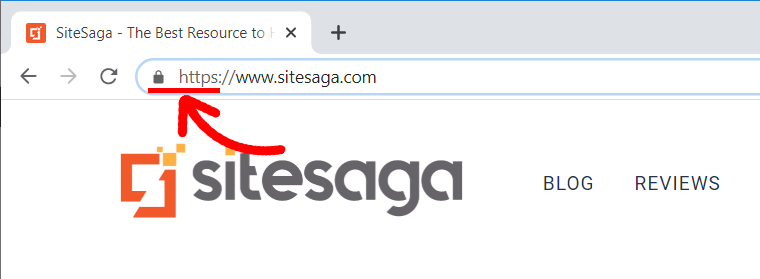
- To encrypt data transmission between your server and the users’ web browsers, secure your website using an SSL certificate. For user trust and SEO rankings, this is essential. Let’s Encrypt offers free SSL certificates.
iv. Canonical Tag
- Use canonical tags to prevent problems with duplicated content. When there are many versions of a page with the same content, canonical tags identify the preferred version.
- Example: <link rel=”canonical” href=”https://www.example.com/page” />
v. Fixing Broken Links and Errors
- Check for broken links regularly and fix them. Broken links can harm SEO and the user experience. Screaming Frog and other tools are useful for this reason.
Keep in mind that technical SEO is an ongoing process that requires staying updated with the most recent best practices.
6. Build and Analyze High-Quality Backlinks
To enhance SEO, high-quality backlinks must be built. As they signal search engines that your website is credible, relevant, and trustworthy.
Backlinks from reputable and relevant websites give your content “votes of confidence” and raise its search engine visibility. Quality backlinks raise the online authority of your website, increasing organic traffic and search engine results.

Low-quality backlinks, on the other hand, can have the reverse impact, resulting in penalties and a drop in rankings. You can enhance your website’s online reputation and increase its chances of showing up higher in SERPs by concentrating on high-quality backlinks.
A Step-by-Step Guide to Building High-Quality Backlinks
Building high-quality backlinks is an essential aspect of SEO that can help improve your website’s visibility and rankings in search engines. Here’s a step-by-step guide on how to build and analyze high-quality backlinks:
Step 1: Understand Backlink Quality
Backlinks are not created equally. Backlinks from reputable and relevant websites in your niche are of high quality. They significantly impact your SEO efforts more than a large number of low-quality backlinks.
Step 2: Research Relevant Websites
Determine which websites are relevant to your niche. Search for websites with a high domain authority (DA) and an excellent reputation in the industry.
Step 3: Create Valuable Content
One of the best strategies to get backlinks is to create high-quality content. Create content that is useful, shareable, and informative so that people will want to link to it.
Step 4: Monitor and Analyze Backlinks
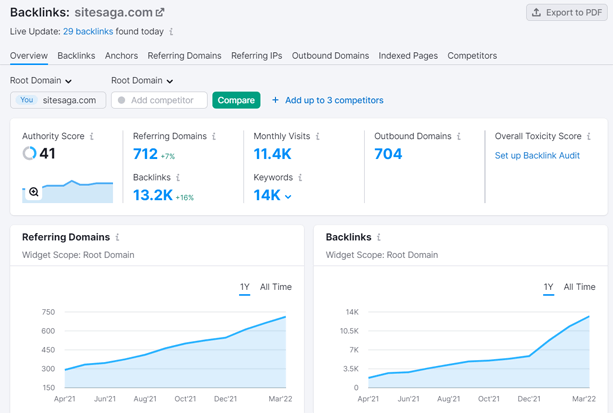
To regularly monitor and analyze your backlinks, make use of tools like Google Search Console, Ahrefs, or Semrush. Find any bad backlinks that can hurt the SEO of your website and remove them to prevent penalties.
Step 5: Build Relationships
Engage with other website owners and content creators in your niche. Developing contacts can result in cooperation and opportunities for links.
Step 6: Guest Posting
Offer to write guest posts for authoritative websites in your niche. If it benefits the article, you can offer to add a link to your website in the writer’s bio or the text itself.
Example: If you’ve got a fashion blog, you’d reach out to a popular brand website and write a guest post about the latest and trendiest fashion. Within the post, you can include a link back to your blog for more stylish and trendy tips.
Step 7: Broken Link Building
Find broken links on trustworthy websites that are relevant to your content. After that, get in touch with the website’s owner and suggest replacing the broken link with a link to your relevant and valuable content.
Example: Suppose you’ve got an article about “10 Best Men’s Summer Jackets.” If you find a website with a broken link pointing to a similar topic, you’d reach out and suggest replacing the broken link with a link to your article.
Step 8: Resource Link Building
Generate extensive, thoroughly researched resource articles or how-to tutorials for your audience. Ask for a link if you can from websites, blogs, and forums that are related to your topic and might find your resource useful.
Example: You could create an in-depth guide on “How to Keep Up With Trendy Fashion” and share it with personal fashion blogs and forums.
Never forget that prioritizing quality over quantity is the secret to effective backlink building. Your SEO can be influenced more significantly by a few high-quality backlinks than by lots of low-quality links.
7. Social Media Promotion
Social media promotion is essential because it enhances online visibility, drives website traffic, and improves search engine rankings. The probability that other people will link to your high-quality information improves when you share it on social media.
Social signals like likes, shares, and comments also signal the interest of users in the content. Additionally, a robust social media presence builds brand authority and promotes brand loyalty, which boosts click-through rates and increases brand searches.

#Tips to Perform Social Media Promotion Yourself
Self-promotion on social media may be a powerful tool for boosting your online presence and increasing website traffic. To get you started, here is a step-by-step guide and a few examples:
- Choose the Right Platforms: Utilize social media platforms that are relevant to your target market and industry. Facebook, Twitter, Instagram, LinkedIn, Pinterest, and TikTok are a few of the most well-known sites.
- Optimize Profiles: Make sure your social media profiles accurately represent your brand’s identity and are complete and consistent. In your bio, provide appropriate keywords and a link to your website.
- Create Engaging Content: Create compelling content that appeals to your audience. Informational blog posts, captivating pictures, videos, and interactive material can all fall into this category. For example:
- If you run a fitness blog, then create a video tutorial on how to workout at home.
- If you’ve got an online store selling handmade bags, then share visually appealing images of your products.
- Consistency: To keep your audience interested, maintain your posting schedule. Schedule posts using social media management tools.
- Use Hashtags: To increase the reach of your content, do some research and include appropriate hashtags. For example:
- #HomeWorkout #FitnessTips #YogaPose
- Engage with Your Audience: React quickly to remarks, messages, and mentions. Establishing a solid connection with your audience creates brand loyalty and promotes social sharing.
- Collaborate and Network: For cross-promotion, team up with blogs, businesses, or influencers in your niche. This may make more people aware of your content. For example:
- Collaborate with a popular fitness influencer to co-create a 7-minute quick workout and share it on both of your channels.
- Run Contests and Giveaways: To improve interaction and your following on social media, organize contests or giveaways. For example:
- Host a “Best Chakrasana Yoga Pose” contest where participants have to share their creations following your tutorial, and the winner receives a prize.
Always keep in mind that social media promotion is all about creating a community and interacting with your followers. You can effectively use social media to promote your work if you put out a consistent effort.
8. Follow SEO Trends and Updates
To maintain a competitive edge in search engine results, it’s important to keep up with SEO trends and updates. The rankings of websites are impacted by regular algorithm updates made by search engines like Google.
By staying updated, you can adapt your SEO tactics to maintain your search engine visibility and attract organic traffic.
To follow SEO trends and updates for DIY SEO, utilize the following strategies:
- Stay Informed: Read reliable SEO blogs, websites, and forums frequently to be informed on the most recent algorithm updates and news in the market.
- Follow Experts: For real-time insights and advice, follow comprehended digital marketing experts and SEO experts on social media.
- Monitor Search Engines: To understand any algorithm modifications, keep an eye out for official statements from well-known search engines like Google.
- Use Tools: Use SEO tools to monitor website performance, keyword ranks, and backlinks to spot potential problems and make fixes.
- Analyze Competitors: Follow the tactics of your competitors to identify effective approaches and places for improvement.
- Test and Adapt: Test several SEO techniques frequently to determine which ones are effective for your website, then modify your strategy as necessary.
- Follow Google’s Guidelines: For the sake of keeping your website safe and free of penalties, strictly abide by Google’s webmaster guidelines.
You can successfully remain on top of SEO trends and updates for efficient DIY SEO by using these techniques.
9. Track and Measure Your SEO Performance
It’s critical to track your SEO performance since it provides useful insights into the effectiveness of your SEO activities. It helps you determine what is working and what needs to be improved, allowing you to adapt your strategy accordingly.
Monitoring keyword ranks, organic traffic, backlinks, and user interaction can help you determine how successful your SEO initiatives are. As a result, it improves search engine visibility and drives more targeted visitors and conversions to your website.
To track your SEO performance while doing SEO yourself, you can follow these steps:
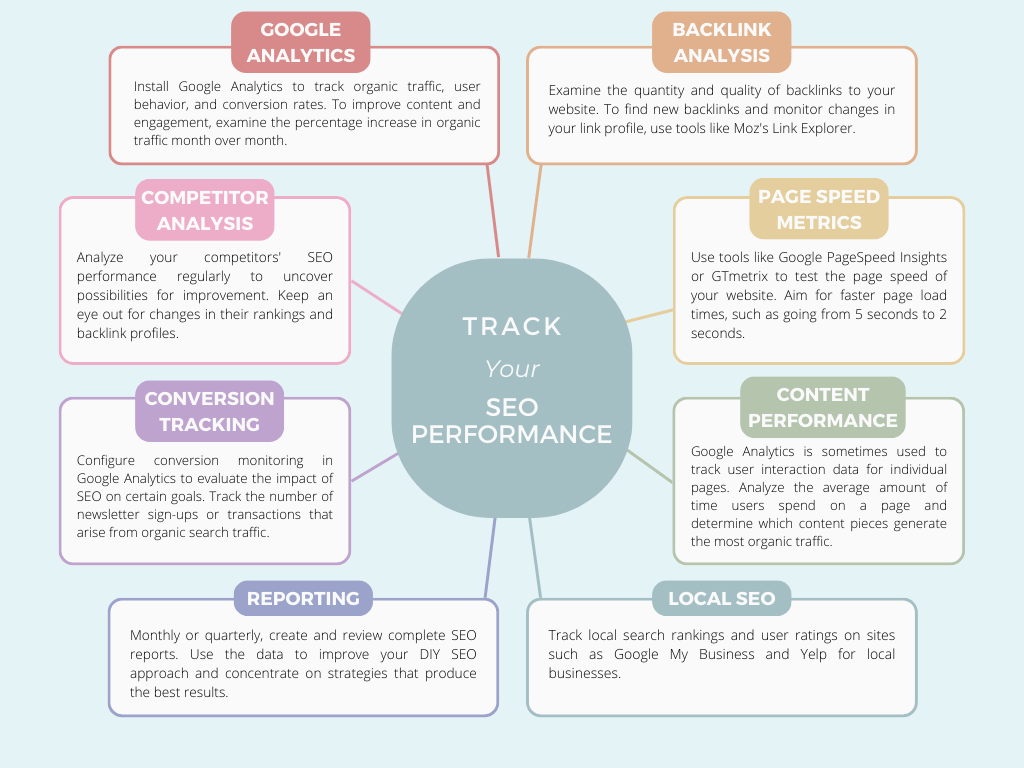
Conclusion
And that’s it, folks! We’ve come to the end of our tutorial on how to do SEO yourself. We hope you now have good insights on how to DIY your SEO strategies for your website.
By following the essential steps outlined in this guide, you can take charge of your website’s visibility and ranking on search engines. Remember to conduct thorough keyword research, create high-quality and relevant content, and build a strong network of backlinks.
While professional SEO agencies offer valuable expertise, take the challenge yourself to understand your website’s strengths and weaknesses.
If you’ve any further questions about how to do SEO yourself, then please leave a comment below. We’ll try to get back to you as soon as possible.
Also, let us know whether you’re doing your SEO yourself or not. You can share your top strategies in the comments section below. Indeed, make sure to share this article with your friends and family too.
You might like our other articles, like the best web hosting for SEO and on-site SEO vs off-site SEO. Make sure to go through it once.
Lastly, remember to like and follow us on our social media handles, Facebook and Twitter, to keep a close eye on our articles.

